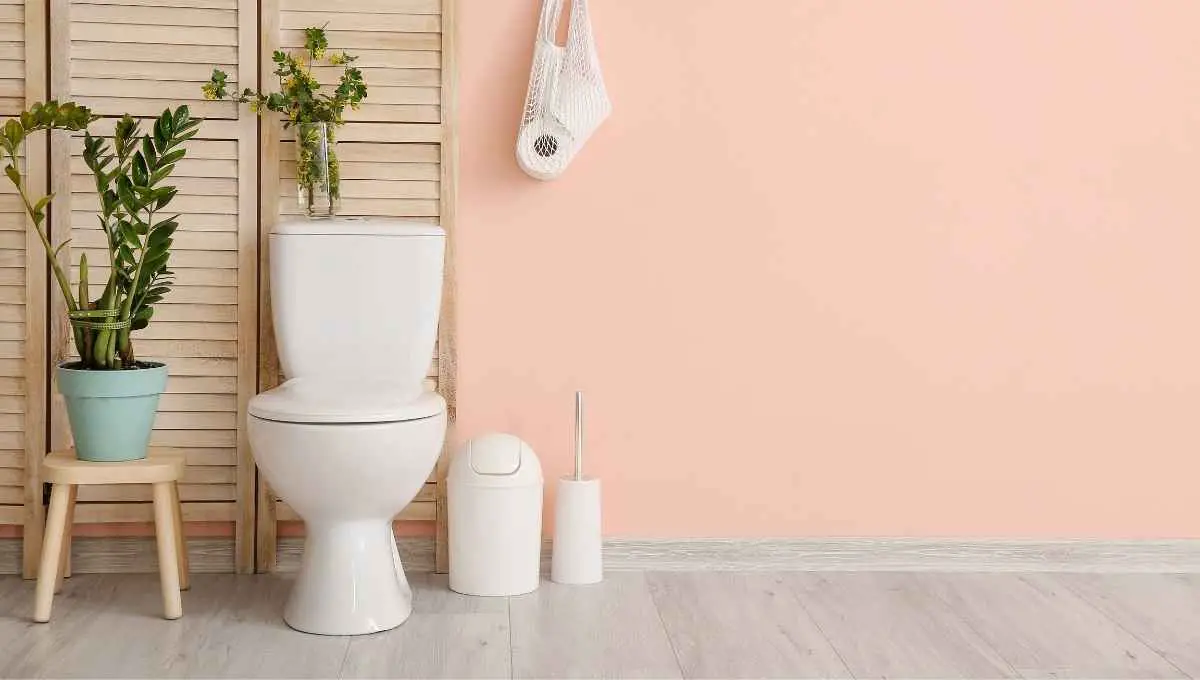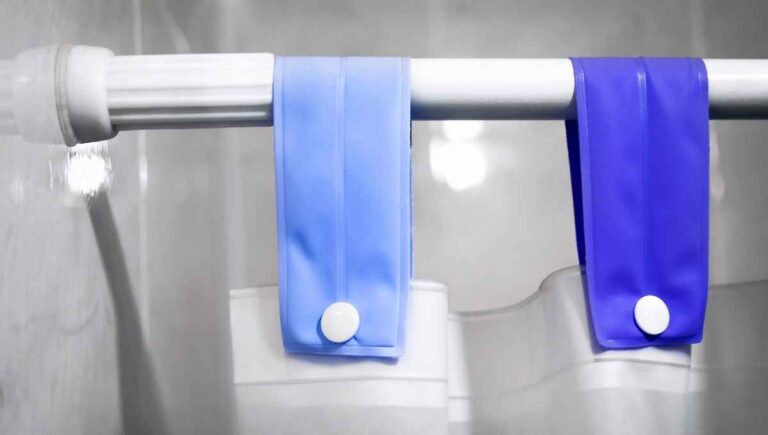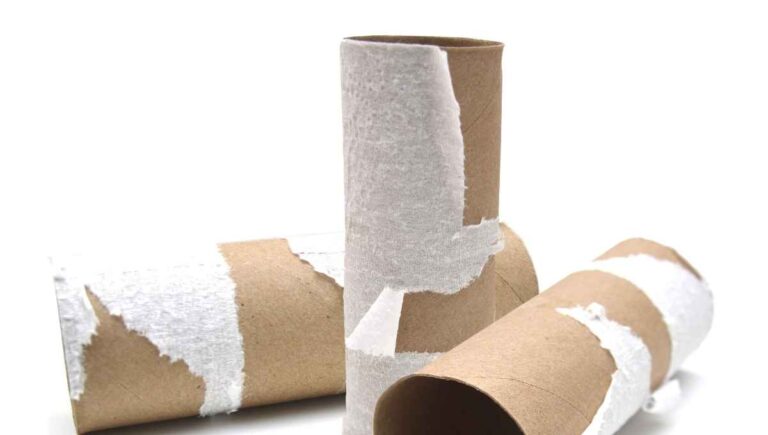Should Toilets Be Against the Wall? (We Asked the Experts)

If you’re looking to remodel your bathroom, you’re probably wondering whether should toilets be against the wall or not. Even though you would want to build your bathroom according to what you’ve planned so far, it’s best to have the right information regarding the correct position of your toilet and avoid complications that may arise.
In most homes, toilets are built against walls to connect the toilet with the pipelines in the wall that provides the water that the toilet needs to flush. Yet, some models are either built to be tight against the wall or simply hang on the wall.
To be able to know the concise answer to this question, you should consider factors like the building codes that apply in your area. In this article, we will disclose whether or not a toilet should be against the wall, what to do if there’s a gap between your toilet and your wall, and what to consider before installing a new toilet.
This post contains affiliate links. This means Household Blogger may earn a commission should you make a purchase using any of our links. Please refer to our full affiliate disclosure policy for full details.
Here’s a Quick Pro Tip!
In most homes, toilets are built against the wall because it’s through there that the toilet connects to the pipeline that provides the water it needs to flush.
Now that you know where your toilet should be placed, it’s time to shop around for that special one!
We think these models will look fabulous in your bathroom:
American Standard Round Toilet – Suitable to any bathroom.
Modern Hanging Toilet – Less cleaning stress with a touch of modernity.
Kennard Dual Flush Toilet – A modern-style classic.
Should My Toilet Be Against the Wall?
Before delving into the secrets about walls and toilets, you should know if it’s okay to have your toilet against the wall.
Does a Toilet Have to Be Against a Wall?
The traditional method of building a bathroom often requires that a toilet is placed at a considerable amount of distance from the bathtub or shower, the sink, the door, and the toilet paper holder. The pipeline that provides water to your toilet is usually within a wall.
Knowing now that your pipeline is often connected to your toilet through the wall, we can safely assume that your toilet can be against your wall while considering the abovementioned measurements.
Should a Toilet Tank Touch the Wall?
Anything that seems merely aesthetical to the building and installation of your bathroom appliances shouldn’t be something to worry about. Yet, if you’re not comfortable with your toilet touching the wall, you can always call a professional to fix it for you.
Most toilet owners have experienced their toilet touching the wall, and oftentimes it’s merely a question of how it looks.
Yet, if this situation is altering the overall functionality of your toilet, you might want to consider fixing it to avoid further issues.
Should a Toilet Cistern Be Screwed to the Wall?
When installing a toilet cistern or tank, the most common cause for worrying is whether or not should it be screwed to the wall. However, this is not typically necessary and therefore shouldn’t be a cause for distress.
What you need to keep in consideration is whether or not the base of your toilet is correctly screwed to the floor.
If it’s not, you may risk having a wobbly toilet that won’t stop rocking back and forth.
Is It Okay if the Toilet Cistern Isn’t Touching the Wall?
Depending on how your bathroom is originally built, sometimes your cistern may seem to be too close or too far from the wall. If this situation isn’t affecting the way that your toilet is intended to work, then it shouldn’t be something that concerns you.
What you need to keep in mind is if your toilet is compliant with the building codes in your area.
The latter could affect the way that your bathroom is intended to work, and could be a reason for sanctions. Always make sure to investigate these matters thoroughly.
You might also enjoy our post on If a Cracked Toilet Tank Can be Repaired
Is It Okay if My Toilet Tank Hits the Wall?
A toilet tank that is close to the wall is not usually a thing to be concerned about unless it’s not adjusted to your preference. A thing that you should keep on the lookout for is whether or not your toilet seems to be wobbly.
Your toilet tank can be close or far from the wall as long as its measurements are correct within your bathroom.
This means that it should be compliant with the standard bathroom requirements to keep it functioning properly.
Is It Okay if My Toilet Is Coming Away From the Wall?
Traditional toilet installations don’t present a problem relating to a toilet coming away from the wall. The only way this could happen is if you have a hanging toilet. In this case, you need to fix it right away to avoid any accidents.
If traditional toilets don’t come away from the wall, they get wobbly if they’re not placed correctly. So, the only way this could happen is if you have a hanging toilet.
You must fix it by hiring a professional handyman or plumber that knows how to deal with these types of toilets.
Logically, having a toilet that can’t stay in place is a nuisance and it could also pose a certain threat to the overall hygiene of your bathroom.
It’s best to take care of it efficiently to avoid any potential gross accidents.
Should There Be a Gap Behind the Toilet Cistern?
Whether the appearance of a gap behind your toilet’s cistern is something meant to occur or not depends essentially on the type of toilet and manufacturer. Therefore, the normality of this depends mostly on the size of the model that you chose.
Some toilet models are meant to leave a 14” distance from your toilet to the wall, while the standard average is 12 inches.
Generally, it wouldn’t be a cause for concern unless it’s either annoying to see or if it causes your toilet to malfunction.
Is My Toilet Placed In The Correct Position?
Before buying a new toilet or remodeling your bathroom, there are things that you need to consider. We’ll disclose it below.
How Far Should My Toilet Be From the Wall?
On average, the distance from your toilet to the wall will depend on your preference. However, in some instances, the toilet should be under a considerable distance from the wall to remain compliant with the building codes in your area.
The average toilet usually has a 12-inch distance from the toilet to the wall.
However, in any case, if this measurement doesn’t work, you can either try something as small as 10 inches or something as big as 15 inches. It’ll depend on the space of your bathroom.
What Do I Need to Consider When Placing My Toilet Near a Wall?
Before installing a new toilet, it’s best to make sure that you have the appropriate space within your bathroom. Considering the dimensions of your toilet and bathroom can help you choose the correct toilet size, and avoid further complications.
Having a clear idea about the space of your bathroom can help you make the correct decisions when choosing a toilet.
Moreover, knowing the building codes of your area or country will help you avoid sanctions from your government.
What’s a Rough-in Measurement?
Whenever you are remodeling your bathroom, taking the measurements of the distance between each of the components that will remain inside is essential to making the proper purchasing decisions. Rough-in Measurements consist of that.
You should measure the following:
- Distance from the back wall to the toilet flange
- The correct amount of space from the right and left sides of the toilet
- The right amount of space in front of your toilet bowl
- The best spot to install the cold water supply line.
The abovementioned measurements also take a huge part in what the building codes are.
However, keep in mind that these may vary depending on state or country, so you must keep updated on these terms.
Is There a Maximum Distance Between a Toilet and a Wall?
The distance between a toilet and a wall will vary depending on the model and size of the toilet. The maximum distance acceptable between a toilet and a wall is 15 inches, but it will always depend on the building requirements in your area.
As much as we’d like toilets to fit everywhere, sometimes we need to find the specific measurements to avoid complications.
Measure everything meticulously and you’ll be able to prevent having to fix your toilet’s position again.
Will My Toilet Function Properly if It’s Too Far From the Wall?
If you made sure to calculate the correct rough-in measurements, then the functionality of your toilet shouldn’t be affected. On the contrary, there could be a risk of your toilet leaking or breaking if it wasn’t done properly.
Normally, if your toilet has a gap that’s just below 2 inches, then it’s nothing to worry about and it can work perfectly fine.
But, if it goes above 2 inches (maybe even 4 inches), then it can be problematic because it can leak and damage your floor.
Of course, having the wrong measurements can lead you to put your toilet in the wrong position and that is when it can malfunction. It will all depend on what space you chose for it.
What’s the Ideal Distance Between a Toilet and the Wall?
The ideal distance between a toilet and the wall is usually 12 inches. In many cases, you might have to buy a smaller toilet (10 inches) or a bigger toilet (14 inches) to make sure that the space between your toilet and the wall is appropriate.
Most often than not, whether it fits perfectly in your bathroom or not will depend on the type of toilet that you chose.
Each manufacturer has its installation codes, and if not done accordingly, you could leave a gap between the toilet and the wall.
What Should the Toilet Flange Distance Be From the Wall?
The ideal distance between the toilet flange and the wall should be 12 inches from the back wall. Whenever you measure this distance, you must measure from a finished wall and not any base molding, as it could be detrimental in the future.
When we hear “toilet flange”, we refer to the pipe fitting that mounts a toilet to the floor but also connects the toilet to the pipeline.
Therefore, now that we know where it’s located, we must measure from the back wall to the center of the flange to know the correct measurement.
What Should the Distance Be Between the Front of Your Toilet to a Wall or Fixture?
According to the building codes within each state, country, or town, the toilet should have a maximum distance of 24 inches from any wall or fixture. Failing to do so will not be convenient for your bathroom space, and it will violate one of the building codes.
The best way to avoid violating this building code is to make sure to have the proper bathroom and toilet dimensions.
In addition, you should consider every component’s distance to make sure to avoid this.
Fixing the Position of a Toilet
Now that you have an idea about what to consider before installing a toilet, you can understand what to do if you find that your toilet is not positioned correctly against your wall.
What Should I Do if My Toilet Is Too Far From My Wall?
The procedure that should be taken if you find your toilet to be too far from your wall is to make sure that you made the correct calculations of the rough-in measurements. After, you should contact the toilet’s manufacturer to receive more information.
With this information at hand, you can proceed later to determine if you need to replace your toilet entirely, or if you can just fix the position adequately and to your liking.
Of course, you must keep in mind the rough-in measurements to avoid further complications.
You might also enjoy our post on How to Fix a Cracked Toilet Seat
How Do You Fix a Gap Between a Toilet and the Wall?
Having a gap behind your toilet is a very uncomfortable experience. However, measuring the gap can let you know if it’s something serious or not. Generally, an unharmful gap will not be more than 2 inches long. In the case of more, it should be fixed.
Sometimes you can fix a gap by filling the space between the toilet and the wall with wood, and later painting it so that it matches your toilet’s color.
Other times, you might want to consider replacing the toilet, making sure to measure the correct size for your bathroom space.
Can I Move My Toilet Closer to the Wall?
Oftentimes, the most correct way to fix your toilet’s position is to move it closer to the wall. The ability to do this depends on many things, including the current position of the toilet flange and the space requirements that your bathroom must fulfill.
You could move your toilet closer to the wall, but keep in mind that this isn’t an easy task and it will require you to consider moving other elements that also form part of your toilet.
One of these elements includes the flange of your toilet.
How Do I Move a Toilet a Few Inches Closer to the Wall?
If you consider moving your toilet a few inches closer to the wall, you need to make sure to know a few things first. You might need to move other toilet components, such as the supply line and the waste line. You should hire a professional to help you.
Sometimes you might need to replace the current flange that your toilet has for this movement to be possible.
Using an offset flange will allow you to move your toilet without further complications. You can find them in any store, or online.
Before the official process begins, your bathroom floor must be covered with towels, rags, or newspapers, because it is expected to have some water come out of the toilet when it’s being detached from the floor.
Once this is settled, you should be able to shut off your toilet’s water supply and drain the remaining water from inside the toilet bowl.
In many cases, it’s recommended to shut your entire house’s water supply to avoid further complications due to flooding.
After these steps are made, you should proceed to do the following:
- Disconnect the water supply hose, which is usually located on the underside of the toilet tank.
- Proceed to detach the toilet from the floor by removing the bolts and nuts that keep it attached.
- Lift your toilet from the floor. Do not do it alone, as it usually weighs from 70 to 150 pounds.
- File down the sewer pipe, and later plug it to avoid gases spreading in your house.
- Remove the old flange and install the new one.
- Reattach the toilet again.
Is It Difficult to Move a Toilet a Few Inches?
The difficulty that exists when moving a toilet a few inches relies mostly on all the steps that you must follow to make this possible. As this can also include some plumbing movements, like moving the toilet flange, it could be better to hire a professional.
If you are experienced with plumbing and toilets, then this shouldn’t be too difficult for you as you already have the experience to be able to do it.
But in the case that you don’t have this expertise, you should hire a professional plumber to do the job.
If you are in an economical tight spot, then maybe you want to consider doing it on your own. In this case, you should make sure to read all the appropriate information that can help you do it swiftly and efficiently.
Whether or not you should do it on your own, you shouldn’t do it alone.
Toilets can be very heavy and they could hurt your back if you make a wrong move, so if you dare fix it alone, it’s better if you have an extra helping hand to accompany you along the way.
You might also enjoy our post on If a Toilet Can Fall Through the Floor
Related Questions
Can My Toilet Fall Through the Floor?
Although it’s rare to hear about these types of accidents happening, it’s not impossible. If the structure of your house or apartment wasn’t properly built, it could cause the floor to yield to the pressure of the weight of your bathroom appliances.
Normally, these types of accidents will probably occur on a two-floor building (or more). This is why it’s important to make sure to have your property undergo an inspection process.
This can help them detect any funny things, and prevent these accidents from happening.
How Do You Fix a Wobbly Toilet?
Your toilet may wobble if its base is not properly attached to the floor. It can only take the tightening of the bolts and nuts to fix it. Yet, there are instances in which doing this may not help, so it’s best to investigate further to find the cause for this.
If the toilet keeps rocking back and forth because it’s attached to an uneven floor, you can use plastic shims to make it stay still.
You can find them anywhere online, and it’s not a difficult task either. Other times, the culprit might be your toilet’s flange!
In essence, there are three ways to do it depending on why is it that it’s wobbling. These are:
- Replacing the toilet flange
- Tightening the toilet’s bolts
- Using shims
- Repair your floor level
Final Thoughts
Most homes will have a toilet that is built to be against the wall. Sometimes, it could have a gap between your wall and its tank.
While it’s not something that should be concerning, you should measure the length of the gap. If it’s less than 2 inches, there should be no problem.
Moving your toilet to fix its position can be tedious because you might need to move other toilet components.
If you have a gap that is longer than 2 inches, you risk having a leak or simply not having your toilet flush to the wall.
To avoid dealing with these situations, it’s best to consider the rough-in measurements.
In case you need more information about what these are, you can check anywhere on the net or simply call your toilet’s manufacturer so that it can provide you with the right information.







